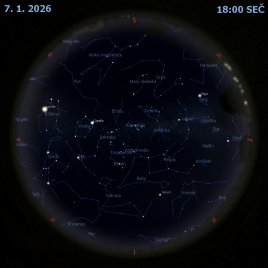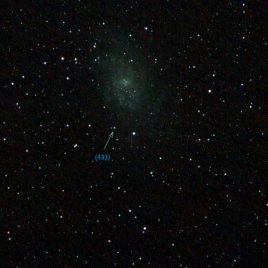Uran a měsíce v pohybu
Uznání videa: David Campbell (U. Hertfordshire), Bayfordbury Observatory
Co se to pohybuje na obloze? Planeta, která je příliš slabá na to, než aby byla vidět pouhým okem: Uran. Tento plynný obr za Saturnem byl počátkem tohoto měsíce sledován kolem opozice, kdy byl Zemi nejblíže a byl tedy nejjasnější. Na čtyřhodinovém časosběrném videu z observatoře v Bayfordbury v okrese Hertfordshire, UK je vidět Uran se svými čtyřmi největšími měsíci v řadě za sebou: Titania, Oberon, Umbriel a Ariel. Zdánlivý pohyb Uranu kolem hvězd v pozadí ve skutečnosti odpovídá především oběžnému pohybu Země kolem Slunce. Kříž se středem na Uranu tvoří difrakční paprsky, které vznikají ohybem, tedy difrakcí světla kolem čtyř ramen, které drží na místě jedno ze zrcadel dalekohledu. Rotace difrakčních paprsků nezpůsobuje rotace Uranu, ale vpodstatě rotace Země. Uran samotný bude v několika dalších měsících vidět triedrem, ale jeho měsíce, jako ostatně vždycky, budou vyžadovat dalekohled.
Seznam odkazů v popisu
- NASA: Uranus
- APOD: 2017-09-11 Cassini se blíží k Saturnu
- NASA: Opposition_Conjunction.jpg
- Twitter: University of Hertfordshire Observatory: Last night Uranus reached opposition. We tracked it over 4 hours to make this video showing the movement...
- Wikipedia: File:Bayfordbury_campus_(27115264794).jpg
- Herts.ac.uk: Bayfordbury Observatory
- Wikipedia: Hertfordshire
- Wikipedia: United_Kingdom
- SETI.org: Uranus Ephemeris Generator 2.8
- APOD: 2000-09-30 Brázdy na Titanii
- NASA: Oberon
- Wikipedia: Umbriel_(moon)
- NASA: Ariel
- APOD: 2020-12-12 Saturn a Jupiter v létě 2020
- Youtu.be: Uranus 101 | National Geographic
- Wikipedia: Diffraction_spike
- Uiuc.edu: Diffraction of Light - light bending around an object
- Flickr.com: bayfordburyobs: University of Hertfordshire Observatory
- Youtu.be: Dancing Uranus
- APOD: 2020-07-01 Naše otáčející se Země
- EarthSky.org: Uranus at opposition November 4
- 1funny.com: Foto: Buldog se dívá dalekohledem :-)
NASA Official: Phillip Newman Specific rights apply. NASA Web Privacy Policy and Important Notices
A service of: ASD at NASA / GSFC & Michigan Tech. U.
Odkaz na originální APOD


